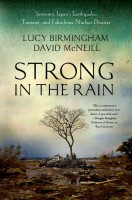 Author: Lucy Birmingham and David McNeill
Author: Lucy Birmingham and David McNeill
Publisher: Palgrave Macmillan
ISBN: 9781137278944
Released: April 2014
Original release: 2012
Lucy Birmingham and David McNeill’s Strong in the Rain: Surviving Japan’s Earthquake, Tsunami, and Fukushima Nuclear Disaster was initially released as a hardcover volume by Palgrave Macmillan in 2012, a little more than a year and a half after the country’s threefold crisis that began on March 11, 2011. Both Birmingham and McNeill were established correspondents based in Tokyo who covered the March 2011 disaster—Birmingham writing for Time and McNeill writing for The Independent, Irish Times, and The Chronicle of Higher Education. Strong in the Rain, deriving its title from a poem by Kenji Miyazawa which became something of an anthem for the country and the disaster’s survivors, was later released as a trade paperback in 2014. It was this edition that I had the pleasure of receiving for review through LibraryThing’s Early Reviewers program. I had heard very good things about the original release of Strong in the Rain and so was looking forward to finally reading the work.
On March 11, 2011 an extraordinarily powerful earthquake occurred off of the northeast coast of Japan. Later estimated to have registered at at least a magnitude of 9.0, the earthquake was extremely violent. It moved the main island of Japan as much as eight feet in some areas and shifted the Earth’s axis. Aftershocks from the quake continued to be felt years later. However, the tsunami that was triggered by the earthquake accounts for much of the immediate damage associated with the March 2011 disaster. It wiped out entire communities along the coast and reached much further inland than anticipated. Japan has been subject to massive earthquakes and tsunami in the past, but what made the events of March 2011 particularly devastating was the resulting meltdown of the Fukushima Daiichi Nuclear Power Plant, culminating in one of the world’s worst nuclear crises. Japan’s recovery continues to this day; the country will have to deal with the impacts of the disaster for years to come.
Strong in the Rain is an excellent volume touching on many different parts of the March 2011 disaster. It’s written in an incredibly engaging manner but without sensationalizing the subject matter. Birmingham and McNeill incorporate their own personal experiences and have also conducted a great deal of research and investigative journalism. The narrative of what happened during and after the earthquake, tsunami, and nuclear disaster relies heavily on their interviews with six survivors: Katsunobu Sakurai, mayor of the coastal city of Minamisoma, who would become one of the most publicly recognized figures following the disaster; Kai Watanabe, a pseudonym of one of the maintenance workers at the Fukushima plant; Yoshio Ichida, a fisherman from Soma; David Chumreonlert, an American elementary school English teacher in Higashi-Matsushima; Setsuko Uwabe, a cook at a public nursery school; and Toru Saito, a recent high school graduate who was looking forward to attending Tohoku University that following April.
In addition to the personal accounts of the events surrounding Japan’s threefold disaster, Strong in the Rain also provides a scientific, historic, and cultural context for the catastrophe. The volume includes charts, maps, photographs, as well as a helpful index. Told in ten chapters (in addition to a prologue and epilogue), Strong in the Rain addresses many of the aspects and complexities of the March 2011 disaster: the quake, tsunami, and nuclear crisis themselves, but also the failure of the floodgates and other protective measures, the reaction of the imperial family, how news coverage was handled domestically and by the international media, the evacuation of foreign citizens, rescue and recovery efforts, how survivors dealt with the tragedy and death tolls, and the spirit and resilience of those living in the affected Tohoku region. Strong in the Rain forms a comprehensive overview of the March 2011 disaster and its ongoing effects. Even years after it was initially published, Strong in the Rain remains an approachable and informative work.
Thank you to Palgrave Macmillan for providing a copy of Strong in the Rain for review.
